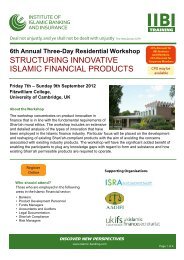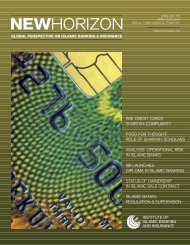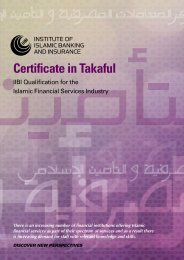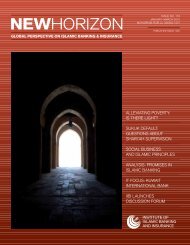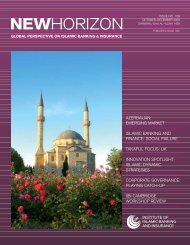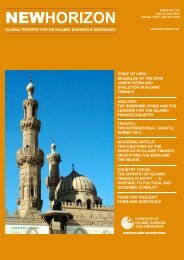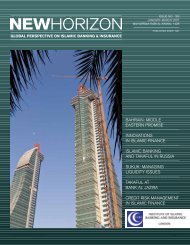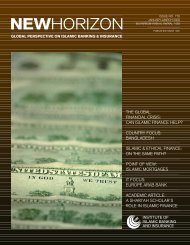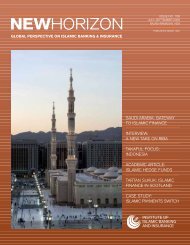HORIZON
issue no. 183 - april–june 2012 / jumada-al-awwal - Institute of ...
issue no. 183 - april–june 2012 / jumada-al-awwal - Institute of ...
- No tags were found...
Create successful ePaper yourself
Turn your PDF publications into a flip-book with our unique Google optimized e-Paper software.
NEW<strong>HORIZON</strong> Jumada-Al-Awwal to Rajab 1433<br />
ANALYSIS<br />
Restructuring Sukuk Transactions<br />
By: Debashis Dey, Stuart Ure and Peter Wielgosz, Clifford Chance LLP<br />
In contrast to conventional<br />
bonds, which represent the<br />
issuer’s contractual debt<br />
obligations to bondholders,<br />
sukuk represent an undivided<br />
beneficial ownership interest in<br />
an underlying tangible asset<br />
and therefore a right to receive<br />
a share of profits generated by<br />
such an asset base, which can<br />
be structured to produce a<br />
fixed income return.<br />
Overview<br />
In the wake of the recent global financial<br />
turbulence, the Eurozone debt crisis and the<br />
resulting volatility in international capital<br />
markets, issuers are actively looking at<br />
reviewing their capital structures. Indeed,<br />
many Gulf-based issuers are examining the<br />
application of liability management<br />
strategies and/or restructuring strategies in<br />
the context of their existing sukuk<br />
transactions. Some are asking whether it is<br />
possible to achieve a waiver or amendment<br />
through a consent solicitation if their<br />
financial covenants are being stressed.<br />
Questions such as ‘can we buy-in and cancel<br />
debt at relatively depressed prices?’ or ‘can<br />
we extend the maturity of an outstanding<br />
series of debt securities, by exchanging it for<br />
a new series of longer-dated instruments?’<br />
are increasingly raised with legal and<br />
financial advisers.<br />
In the first part of this article, we<br />
examine the challenges involved in a<br />
liability management exercise for a sukuk<br />
as compared to a conventional debt<br />
issuance and explore some common<br />
restructuring techniques. These techniques<br />
form the building blocks for a possible<br />
approach to restructuring a sukuk<br />
transaction, which is set out in the second<br />
part of the article. Acknowledging that the<br />
challenges in each liability management<br />
exercise for a sukuk will be different and<br />
will depend on the specific underlying<br />
Islamic structure, in the final section we<br />
refer to recent market examples to<br />
demonstrate that it is possible to implement<br />
restructurings, which have the same<br />
commercial effect for an obligor seeking to<br />
manage its outstanding liability under a<br />
sukuk transaction.<br />
Common Debt Restructuring Techniques<br />
An issuer seeking to restructure its<br />
outstanding debt securities has several tools<br />
for liability management at its disposal.<br />
Without exploring the alternatives available<br />
to it under applicable bankruptcy rules,<br />
which lie outside the scope of this article,<br />
the company may decide between a number<br />
of strategies, the most common of which<br />
involve a tender offer, exchange offer,<br />
consent solicitation or any combination of<br />
these. Although such options are available<br />
to both issuers of conventional debt<br />
securities and sukuk (the Shari’ah-compliant<br />
alternative to conventional interest-bearing<br />
fixed income securities), implementing one<br />
or more of the above strategies becomes<br />
significantly more complicated in the case of<br />
restructuring sukuk transactions. The<br />
reason for this added complexity lies in the<br />
nature of sukuk as an asset-based security.<br />
In contrast to conventional bonds, which<br />
represent the issuer’s contractual debt<br />
obligations to bondholders, sukuk represent<br />
an undivided beneficial ownership interest<br />
in an underlying tangible asset and therefore<br />
a right to receive a share of profits<br />
generated by such an asset base, which can<br />
be structured to produce a fixed income<br />
return. Furthermore, for a sukuk structure<br />
to be Shari’ah-compliant, there must be a<br />
direct link between the assets that underpin<br />
the cash flows on the sukuk and the<br />
ownership interest of the investors in such<br />
assets. Typically, this link can be achieved<br />
through the ‘sale’ and consequential transfer<br />
of title of an asset to a newly formed special<br />
purpose vehicle (SPV) that will hold such<br />
assets on trust or as agent for the investors.<br />
As a result of the inherent proprietary<br />
nature of sukuk, the implementation of<br />
some of the liability management strategies<br />
outlined above is more complex and has<br />
greater limitations than the application of<br />
similar strategies to conventional debt<br />
securities. The limitations of these strategies<br />
as applicable to sukuk restructurings are<br />
explored further below.




